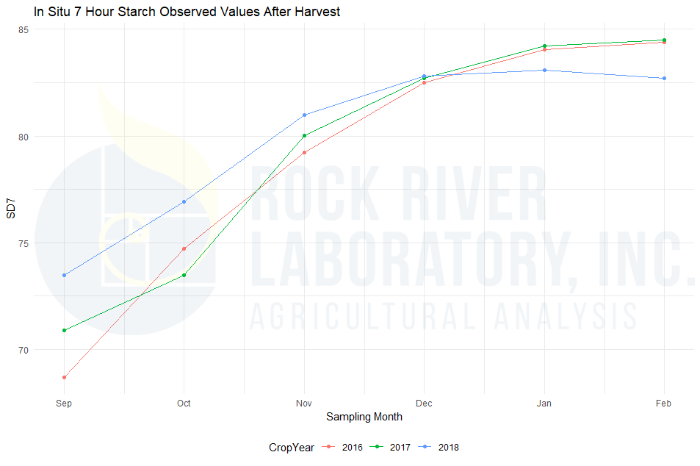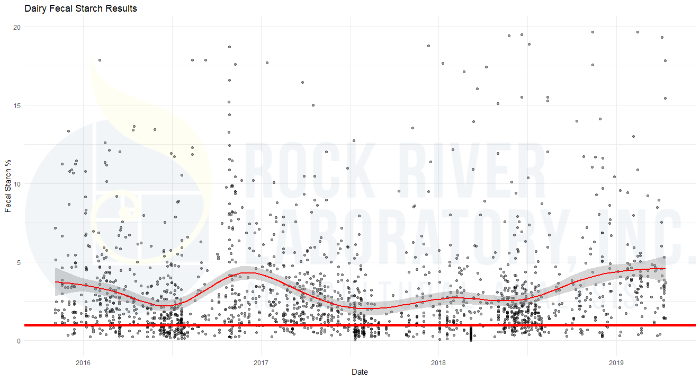By: Cliff Ocker, Director of sales and client relations
Starch is a key component of all lactating dairy diets. Like fiber, it isn’t just about how much is in the diet but more about how much is digested or utilized. Starch digestion can also be characterized by fast versus slow digestion as well as digestible versus undigestible, and volume matters – especially in relation to what’s exiting an animal. This ‘wild turkey feed’ is not the objective when feeding dairy cattle. So, what happens when such an important piece of the ration – corn silage – is harvested in less-than-ideal conditions that directly affect starch? The Midwestern and Eastern US 2018 corn silage crop is a real example of this challenging story. The outcome is a starch conundrum that hasn’t been seen in years.
Typically, by this time of year we see starch digestibility as good as it’s going to get in last fall’s corn silage crop. In 2018, the biggest challenge to that norm was the dry matter level of the corn silage at harvest. This high dry matter lead to a poorer fermentation – essentially reducing the ‘typical’ softening of the corn kernels over time in storage. Unusually dry corn silage at harvest also meant that the plant’s kernels were more mature and much harder than normal when harvested, compounding the issue. The results of the challenging 2018 harvest are painted across the in situ 7-hour starch data from our Rock River Laboratory database [Figure 1].
Figure 1: In situ Starch Digestibility at 7 hours, as % of starch.

We can see where typical starch digestibility would run year to year, and normally it would increase over time in storage. Fermentation acids help with this, but unfortunately the 2018 crop didn’t undergo quite the same fermentation as previous years’ crops and starch digestion appears to have maxed out or plateaued before reaching the typical or expected level.
We want starch to be fairly fast, with the majority breaking down in the rumen. Typically starch digestion in corn silage continues to improve through February and March, but the 2018 crop appears to have peaked in December.
One way to check actual starch digestion is to analyze fecal matter. Figure 2 showcases fecal starch data through the years. Notice the elevated levels during new crop corn silage feeding each fall, and then lower values as the forage ferments - this is normal and expected. In the fall of 2018, the fecal starch values increase as usual, however, now several months into 2019, the fecal starch has not decreased as it should with improved starch digestibility. This means there is less starch being digested or utilized by the animal, meaning more starch is passing all the way through the animal creating the problem of ‘wild turkey feed’ I mentioned earlier.
When considering sampling fecal material for starch, I recommend keeping a few things in mind:
- It is best to sample six to ten animals in the herd, ideally from cows less than 150 Days in Milk (DIM) as we want to know what the high producers are doing.
- Collect an extremely fresh sample that is free of contaminations like bedding, then mix it well and place the sample into a screw-cap container.
- Freeze the sample prior to shipment to stop enzyme activity and retrieve the most accurate result.
Figure 2: Variation in fecal starch

Nutritionally, when starch digestion is less than expected, adjustments need to be made or the diet is left with less energy than expected - potentially changing the efficiency of the rumen.
This affect can be far reaching and costly. For instance, less energy from the diet means that animals will pull more weight from their back, or produce less. If additional fat storage is mobilized, this can adversely affect reproduction and immune function, especially when coupled with other stress factors like overcrowding, heat stress and feed hygiene related items, such as mycotoxins, mold and yeast, clostridia and enterobacteria.
The more you know about the starch challenges of the corn silage that is left for feedout in 2019, the better. Instead of just looking at 7-hour starch analysis, consider choosing an analysis package that offers additional time points. -0- and 3-hour starch data points may help observe how quickly starch will break down within the cow. I usually suggest sending in fecal starch samples if lower starch digestibility values are observed in corn silage or high moisture corn, to see what exactly is passing through the animals. Once you find how much starch is passing, adjustments can be made in the diet. A nutritionist may decide to add dry ground corn, consider a different starch source, or tweak the ration formulation in other ways to supplement the low starch digestibility.
As 2019 continues to unfold and more of the 2018 crop is fed out, the mantra remains to assess and proactively remedy. Considering the significant impact of starch digestion in this story is vital. Attempting to reactively deal with starch challenges can leave herds with decreased feed efficiency and reduced performance – neither of which are tolerable in the current dairy climate.


